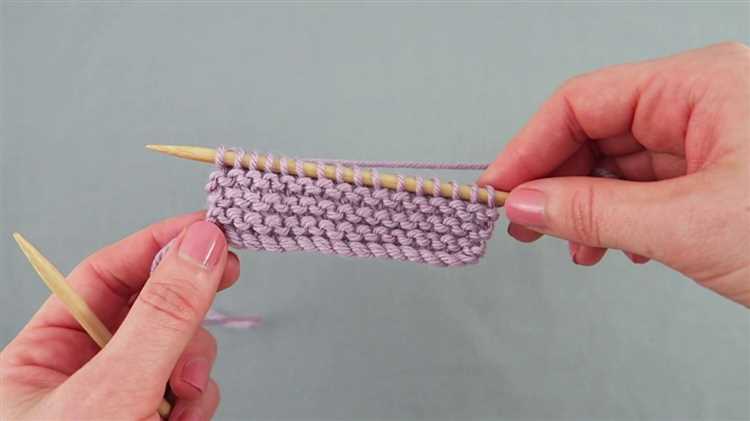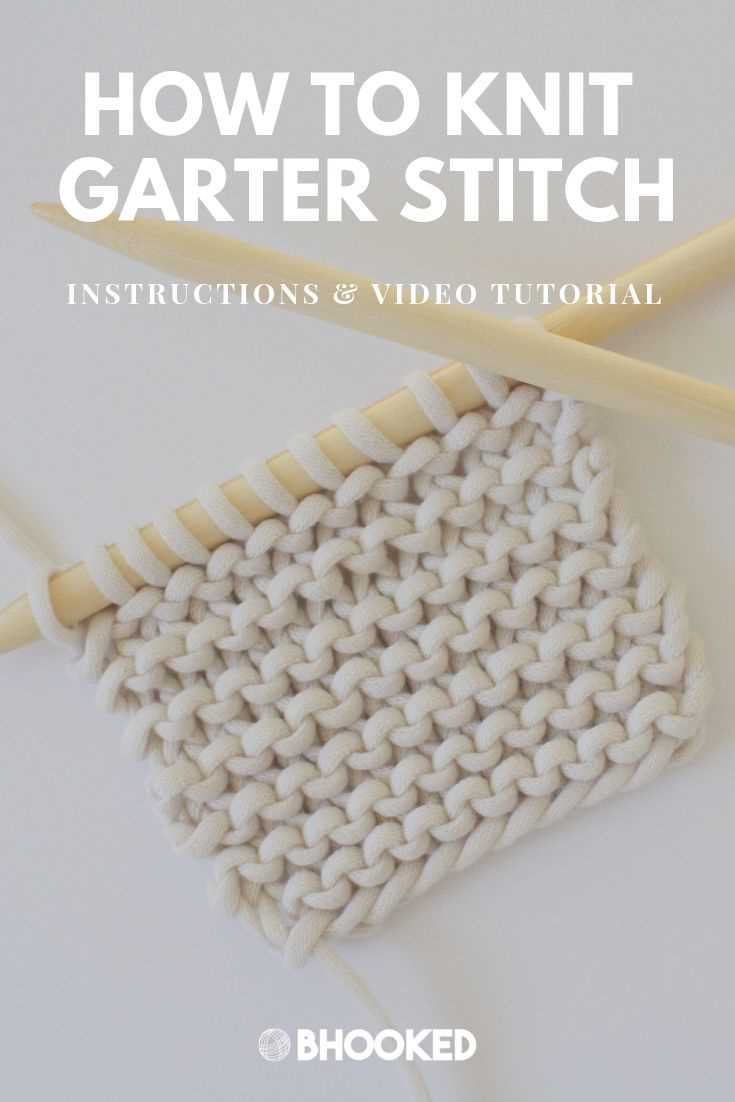Knitting is a popular craft that allows you to create beautiful and functional items with just a pair of needles and some yarn. One of the most basic and versatile knitting stitches is the garter stitch. The garter stitch creates a fabric with ridges or rows of knitted loops on both sides, making it reversible and perfect for scarves, blankets, and other projects.
Learning how to knit the garter stitch is a great place to start for beginners. It requires only the knit stitch and is an excellent way to practice tension and refine your knitting skills. In this step-by-step guide, we will walk you through the process of knitting the garter stitch, from casting on to binding off.
To begin, you’ll need a pair of knitting needles and some yarn. Choose a yarn that is suitable for your project and a needle size that matches the yarn’s recommended gauge. It’s also helpful to have a tapestry needle for weaving in loose ends.
Once you have your materials ready, you can start by casting on the desired number of stitches. Hold the knitting needle with the slipknot in your right hand and the empty needle in your left hand. Insert the right needle into the slipknot from left to right, behind the left needle. Wrap the yarn around the right needle, moving from back to front, and pull it through the slipknot, creating a new stitch. Repeat this process until you have cast on the required number of stitches.
Pro Tip: If you’re new to knitting, it’s a good idea to start with a small number of stitches (around 20-30) until you become more comfortable with the technique.
Materials Needed for Knitting the Garter Stitch
Before you can start knitting the garter stitch, there are a few materials that you will need to have on hand. These materials will help you create the knitted fabric and make the process smoother and more enjoyable.
1. Yarn
The most important material for knitting the garter stitch is yarn. You will need a suitable yarn that is appropriate for your chosen project. The yarn should be soft, easy to work with, and suitable for the size of knitting needles you will be using. Choose a color that you love and that will complement your finished project.
2. Knitting Needles
Knitting needles are essential for knitting the garter stitch. You will need a pair of knitting needles that are the appropriate size for your yarn. The size of the needles will determine the size of your stitches and the overall tension of your knitted fabric. Choose knitting needles that feel comfortable in your hands and are suitable for your skill level.
3. Scissors
Scissors are essential for cutting your yarn at the end of your project and for any necessary trimming or adjusting during the knitting process. Choose a pair of sharp scissors that are suitable for cutting yarn.
4. Stitch Markers
Stitch markers can be helpful for marking specific stitches or sections of your knitting. They can be used to keep track of increases, decreases, or any other stitch pattern you are following. Choose stitch markers that are easy to slide onto your knitting needles and won’t get in the way while you are knitting.
5. Measuring Tape
A measuring tape is essential for checking your gauge and measuring the dimensions of your finished project. It can also be used to measure the length of your knitting needles or the size of your stitches. Choose a flexible measuring tape that is easy to work with and has clear markings.
6. Yarn Needle
A yarn needle is used to sew in any loose ends or join pieces of knitted fabric together. Choose a yarn needle that is large enough to accommodate your yarn and has a large eye for threading the yarn through.
7. Stitch Holder or Waste Yarn
If you need to set aside stitches for a later step or to be worked on separately, you will need a stitch holder or waste yarn. These tools will help you keep your stitches secure and prevent them from unraveling. Choose a stitch holder or waste yarn that is compatible with your knitting project and easy to work with.
With these materials on hand, you will be well-prepared to start knitting the garter stitch. Happy knitting!
Step 1: How to Cast On Stitches for Garter Stitch
To begin knitting the garter stitch, you’ll need to cast on your stitches. The cast on is the foundation row of stitches that you’ll be working with. Here’s how to cast on stitches for the garter stitch:
- Start by making a slipknot. To do this, create a loop with your yarn, then pass one end of the yarn through the loop to create a knot. Adjust the loop so that it fits snugly on your knitting needle.
- Hold the knitting needle with the slipknot in your right hand. With your left hand, take the working end of the yarn (the end that is attached to the ball) and place it behind the needle, leaving a tail that is long enough for the number of stitches you want to cast on.
- Using your right hand, insert the knitting needle into the slipknot, going from front to back. The slipknot should now be on the knitting needle.
- With your left hand, bring the working end of the yarn over the top of the knitting needle, creating a new loop.
- Using your right hand, pull the new loop through the slipknot, creating a new stitch on the knitting needle. This stitch will be your first cast-on stitch.
- Repeat steps 3-5 for the desired number of stitches. Each time you create a new stitch, slide it down towards the tapered end of the needle, so that it is close to the slipknot.
- Once you have cast on all of your stitches, you’re ready to start knitting the garter stitch!
Note: The number of stitches you cast on will depend on your project and the desired width. Make sure to check your pattern or project instructions for the correct number of stitches to cast on.
Step 2: How to Knit the Garter Stitch
Once you have your knitting needles and yarn ready, it’s time to start learning how to knit the garter stitch. Follow these steps to get started:
- Hold the Knitting Needles: Hold one knitting needle in each hand. The needle in your right hand should be the active knitting needle, while the one in your left hand will hold the stitches.
- Cast On Stitches: To begin, you’ll need to cast on an even number of stitches onto your active knitting needle. There are various methods you can use to cast on stitches, such as the long-tail cast on or the knitted cast on. Choose a method that you find comfortable and cast on the desired number of stitches.
- Start the First Row: With your active knitting needle in your right hand, insert it into the first stitch on your left-hand needle from left to right, going under the left-hand needle. Make sure the working yarn is behind your work.
- Knit the Stitch: Wrap the working yarn around the active needle from back to front, creating a loop. Then, pull the active needle through the loop, bringing the stitch from the left-hand needle to the right-hand needle.
- Continue to Knit: Repeat step 4 for each stitch on the left-hand needle until all the stitches have been transferred to the right-hand needle. This completes your first row of garter stitch.
- Knit Every Row: To create the garter stitch pattern, simply continue knitting every row, using the same technique as described in steps 3 and 4. There is no need to purl any rows when knitting the garter stitch.
- Finish Your Knitting: Once you have reached the desired length for your knitting project, you can bind off your stitches. There are different methods for binding off, such as the basic bind off or the stretchy bind off. Choose a method that suits your project and bind off all stitches to secure your work.
Remember, practice makes perfect, so don’t worry if your first few rows don’t look perfectly even. With time and practice, you’ll be able to knit the garter stitch with ease.
Step 3: How to Increase Stitches in Garter Stitch
Increasing stitches in garter stitch is similar to increasing stitches in other knitting patterns. This technique allows you to add more stitches to your project, making it wider and increasing its size.
Here’s how you can increase stitches in garter stitch:
- Knit the first stitch as you normally would.
- Insert the right needle into the stitch below the next stitch on your left needle, going from back to front.
- Take the yarn and wrap it around the right needle counterclockwise, just like you would when knitting.
- Pull the wrapped yarn through the stitch, creating a new stitch on your right needle.
- Slip the old stitch off the left needle, giving you two stitches on your right needle.
- Continue knitting the remaining stitches as usual.
This increase technique, also known as a knit-front-and-back (kfb) increase, creates a small bump on your knitting. It’s a common method used in garter stitch and other patterns to add stitches.
Depending on your project’s instructions, you may need to increase stitches at specific points or regularly throughout the pattern. Be sure to follow the pattern’s guidelines to achieve the desired shape and size.
Increasing stitches can be used to create shaping, such as when making sleeves, ruffles, or flared edges. It’s a versatile technique that allows you to customize your knitting projects.
| Step | Description |
| 1 | Knit the first stitch. |
| 2 | Insert the right needle into the stitch below the next stitch on the left needle. |
| 3 | Wrap the yarn counterclockwise around the right needle. |
| 4 | Pull the yarn through the stitch to create a new stitch. |
| 5 | Slip the old stitch off the left needle. |
| 6 | Continue knitting the remaining stitches. |
Remember practice makes perfect, so keep trying this increase technique until you feel comfortable with it. Have fun experimenting with different stitch patterns and exploring the endless possibilities of knitting!
Step 4: How to Decrease Stitches in Garter Stitch
In garter stitch, decreasing stitches is essential for shaping your project or creating interesting patterns. There are different methods you can use to decrease stitches in garter stitch, including:
- Knit Two Together (k2tog)
- Slip, Slip, Knit (ssk)
- Slip 1, Knit 1, Pass Slipped Stitch Over (skpo)
Here’s how to do each decrease:
- Knit Two Together (k2tog): Insert your right-hand needle into the next two stitches on your left-hand needle as if you were going to knit them together. Knit these two stitches as one stitch. This decrease slants to the right.
- Slip, Slip, Knit (ssk): Slip the next stitch as if to knit onto your right-hand needle. Repeat this with the following stitch. Insert your left-hand needle into the front of these two stitches and knit them together through the back loops. This decrease slants to the left.
- Slip 1, Knit 1, Pass Slipped Stitch Over (skpo): Slip the next stitch purlwise onto your right-hand needle. Knit the following stitch. Insert your left-hand needle into the slipped stitch, lift it over the knit stitch, and off the right-hand needle. This decrease slants to the left.
When decreasing stitches in garter stitch, make sure you are consistent with the type of decrease you use. This will help maintain the symmetry and aesthetics of your project. You can use these decreases to shape sleeves, necklines, or any other design element in your knitting.
Practice these decreases on a small swatch before incorporating them into your project. With some practice, you’ll be able to confidently decrease stitches in garter stitch and create beautiful knit pieces.
Step 5: How to Change Colors in Garter Stitch
Changing colors in garter stitch can add beautiful designs and patterns to your knitting project. Here’s how you can easily change colors:
- Start by knitting to the point where you want to change colors.
- Take your new color yarn and hold it in your right hand, alongside the working yarn of the old color.
- With your right hand, loop the new color yarn over the right-hand needle and hold it against the working yarn of the old color.
- With your left hand, wrap the new color yarn around the right-hand needle and knit the next stitch. This will secure the new color yarn in place.
- Continue knitting with the new color yarn, carrying the old color yarn along the edge of your work.
- If you have a long stretch of one color before switching again, you can twist the two yarns together once on the wrong side of your work to prevent any gaps.
- When you want to switch back to the old color, simply drop the new color yarn and pick up the old color yarn, continuing to knit as usual.
- Repeat these steps whenever you want to change colors in your garter stitch project.
Changing colors in garter stitch allows you to create stripes, color blocks, or other intricate patterns. Experiment with different color combinations to achieve the look you desire. Remember to carry the unused color yarn along the edge of your work to avoid loose or hanging threads.
Step 6: How to Bind Off Stitches in Garter Stitch
Once you have finished knitting your desired number of rows or length in garter stitch, it’s time to bind off your stitches to complete your project. Binding off is a technique used to secure the stitches and create a neat edge.
Follow these steps to bind off stitches in garter stitch:
- Start with knitting the first two stitches in the row as usual.
- Insert the left needle into the first stitch you knitted on your right needle.
- Pass the first stitch over the second stitch and off the right needle.
- Knit another stitch and repeat step 3, passing the previous stitch over the new stitch and off the right needle.
- Continue knitting stitches and passing the previous stitch over until you have one stitch left on your right needle.
- Cut the yarn, leaving a tail of about 6 inches.
- Thread the tail through the last stitch and pull it tight to secure the bind off.
After completing the bind off, you can gently tug on the project to even out the stitches and create a neat edge.
Now you know how to bind off stitches in garter stitch! This technique can be used to finish off scarves, blankets, or any other project knitted in garter stitch.
Final Thoughts on Knitting the Garter Stitch
The garter stitch is one of the easiest and most versatile knitting stitches to learn. It is perfect for beginners as it only requires knowing how to knit, making it a great stitch to practice and build your skills.
Here are some final thoughts to keep in mind when knitting the garter stitch:
- Practice makes perfect: Knitting the garter stitch may feel a bit awkward at first, but with practice, your stitches will become more even and smooth.
- Experiment with different yarns: The garter stitch can be worked with any type of yarn. Try using different weights and fibers to create unique textures and patterns.
- Explore color combinations: The garter stitch is a great way to play with colors. Mix and match different shades to create beautiful striped or gradient designs.
- Consider adding borders or edgings: The garter stitch can be used to create borders or edgings on other knitting projects. Experiment with different stitch patterns to add a decorative touch.
- Be patient and have fun: Knitting is a relaxing and rewarding hobby. Enjoy the process and don’t be afraid to try new things.
Once you’ve mastered the garter stitch, you’ll have a solid foundation for tackling more complex knitting patterns. Whether you’re making scarves, blankets, or other projects, the garter stitch will always be a useful stitch to have in your repertoire.
FAQ:
What is the garter stitch?
The garter stitch is one of the simplest knitting patterns. It is made by knitting every row, creating a fabric with ridges.
Is the garter stitch suitable for beginners?
Yes, the garter stitch is perfect for beginners. It only requires a basic knitting knowledge and is a great way to practice the knit stitch.
How do I start knitting the garter stitch?
To start knitting the garter stitch, cast on the desired number of stitches. Then, knit every row until your project reaches the desired length.
Can I use the garter stitch for different knitting projects?
Yes, the garter stitch can be used for a variety of knitting projects. It is commonly used for scarves, blankets, and dishcloths, but you can also get creative and use it for sweaters, hats, and more.


